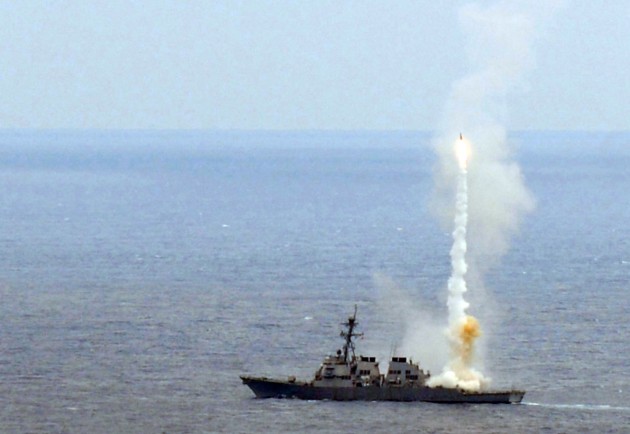More Ships, More Missiles, Less Waiting: Rep. Forbes Talks 2016 NDAA
Posted on

CAPITOL HILL: More ships. More weapons. Less waiting. That’s the essential philosophy of Rep. Randy Forbes, chairman of the House subcommittee on seapower. In the draft National Defense Authorization Act headed for mark-up next week, he certainly seems to have gotten his way — on amphibious assault ships, submarines, land-based cruise missiles, and more.
“My job is to build the Navy we need,” Forbes told me this afternoon — and to convince others to find the dollars.

Rep. Randy Forbes
Arguably the most ambitious single element in the bill is accelerating the next class of amphibious ship, the LX(R), by two years. The LX(R) will be a lower-cost version of the San Antonio-class LPD already in construction — a class to which Congress had already added an extra ship, LPD-28. (After some misgivings about the amount of money required, the Administration acquiesced in this year’s budget and asked for the half-billion dollars required to finish LPD-28, which the bill provides.) Now, having gotten LPD production extended longer than the Navy had planned, Forbes wants to begin LX(R) production earlier. The bill would begin advanced procurement in fiscal ’16 with an eye to starting construction in ’18.
Closing the gap between the end of one class and the beginning of the next accomplishes three things, Forbes said. First, at a time when the industrial base is increasingly wobbly, the change keeps production going at Mississippi’s Ingalls shipyard, rather than stopping with the last LPD and restarting a few years later with the first LXR, which will use the same hull. Second, it puts more amphibs into the fleet faster, addressing a chronic shortfall in one of the Navy’s most in-demand ship types. Third, it gets those amphibs built before the new nuclear missile submarine starts sucking all the oxygen out of the budget.
“It’s about getting these ships built before the Ohio-class [replacement] comes online,” Forbes said, “because obviously that is going to be a big sucking magnet” — unless policymakers can find a way to fund it that doesn’t starve other shipbuilding. “I’ve been arguing all along [that] this needs to be across the department of defense budget, this shouldn’t come out of the Navy’s hide.”
Last year, Congress created a special account for the Ohio Replacement Program, the National Sea-Based Deterrence Fund — but they didn’t put any actual money in it. This year, though, the draft NDAA would move $1.39 billion of Ohio Replacement research out of the R&D accounts into the deterrence fund.
Isn’t this still a shell game, I asked Forbes, moving money around rather than really adding new funds?
“Money always come from other places,” Forbes replied. “That $1.39 billion, that’s real dollars that’s going in there, that we think we have put our fingerprints on very strongly, and $1.39 billion is not small change.”
“This is not a toothless tiger,” Forbes said of the deterrence fund. Besides moving the R&D money, the draft bill gives the Pentagon greater “reprogramming” authority to move money into the fund on its own initiative: Last year’s language just allowed moving money from the Navy Department, this year’s would authorize reprogramming from anywhere in the Department of Defense.
This new authority would allow DoD to sweep up funds that other programs weren’t spending — for example due to production delays — and allocate them to the Ohio Replacement. Otherwise, Forbes said, “if they don’t execute them, sometimes those dollars are lost.” (For example, the draft bill trims funding for the Air Force’s Long-Range Strike Bomber and KC-46A fuel tanker because they’re not progressing, and therefore not spending, at the planned rate).
Admittedly, this kind of reallocation is the Pentagon equivalent of finding quarters in the couch and putting them in a piggybank instead of in your pocket: a helpful bit of thrift, but hardly enough to cover major expenses. For now, the importance of the deterrence fund remains mainly symbolic. One practical advantage the fund would have, however, is a wider and more flexible set of a spending authorities than the traditional Shipbuilding & Construction, Navy (SCN) account.
The bill would also continue Congress’s strong support for the Navy’s Virginia-class attack submarines, which carry torpedoes and conventional cruise missiles rather than nukes. In particular, it urges the Navy to incorporate extra missile tubes, known as the Virginia Payload Module, on every Virginia built after 2019. The current Navy plan only funds a VPM for every other sub.
“This alternating staccato kind of thing…makes no strategic sense,” said Forbes. “It makes absolutely no sense to us to not have the Virginia Payload Module on all of these vessels.”
“The Navy couldn’t come in here and say ‘we don’t need ’em’,” he said. “They could very easily come in and say… ‘we don’t have the money.'”
For all his budget boosterism, Forbes is hardly blind to fiscal limits. When I asked him about Rear Adm. Joseph Tofalo’s recent suggestion to increase Virginia production from two subs a year to three, the congressman politely said it wasn’t feasible. It was good for Tofalo, the Navy’s director of undersea warfare, to broach the topic, Forbes said, but based on his discussions with both the Navy and industry, “it was going to be very difficult for them to execute and to accelerate those programs much more than what we’ve put in there [already].”
Forbes isn’t focused just on new construction: There’s also the save-the-cruisers campaign. Congress first blocked Navy plans to retire seven aging Ticonderoga cruisers, then blocked a Navy proposal to semi-mothball 11 “Ticos” for years of modernization. Last year’s law imposed a “2-4-6” rule: No more than two Ticonderogas could be taken out of service for modernization in any given year, no cruiser could be in modernization for more than four years, and no more than six cruisers could be out of service at any given time. This year’s draft NDAA, however, would tighten that further to 2-2-6: No cruiser may be in modernization for more than two years, halving the allowed time.
“To modernize them, it takes 18 months,” Forbes said. “We’ve given them an extra six months on top of that,” plus an option for a six-month extension in case of problems.
HASC staff acknowledged the shorter modernization period would cost more money. The tighter schedule would give shipyards less leeway to do cruiser modernization during lulls in other work, reducing efficiencies. It would also make it impractical for the Navy to disband the cruiser’s crew during the modernization period, increasing personnel costs. And returning the ships to service faster means they wear out faster, too.
But the first question, Forbes said, is “do you need the cruisers or not?” If you do — and given the increasing threats worldwide, we arguably need more of them than ever, he said — then the next question is how best to modernize them. He clearly does not trust the Navy on that question.
Originally, “their plan, as you know, had nothing to do with modernizing the cruisers: It was euthanizing seven of those cruisers,” Forbes said. Then the Navy came up with a modernization plan that had “not a dime in their Future Years Defense program” to do the actual work, he said, making it mothballing by other means. By imposing a tight two-year limit on how long the Navy can take cruisers out of service for modernization, Forbes said, “what that assures us of is that they’re actually doing the modernization.”
The committee also wants to accelerate work on aircraft carriers. The Navy now plans to build the USS John F. Kennedy, CVN-79, in two phases with a pause in between: The draft NDAA calls for a GAO study of the resulting “costs and delays.” Meanwhile, the bill authorizes funding to move ahead with CVN-79, CVN-80, and CVN-81. It also authorizes refueling the five Nimitz-class carriers yet to be overhauled — another area where Forbes is deeply distrustful of the Administration.
As for the workhorse of the fleet, the DDG-51 Arleigh Burke-class destroyers, the bill would fund the two new ships requested in the budget and add funds for Aegis combat system modernization, which the Administration had slowed down.
To arm all these ships, the bill increases production of Tomahawk cruise missiles to 198 a year. It also orders a Navy study of how to field the laser weapons and electromagnetic rail guns now in testing. Committee staff also said, without providing further detail, that the full committee would consider a “land-based anti-ship missile program.”
Carriers, cruisers, destroyers, and submarines represent the high end of Navy capability. At the low end is the Littoral Combat Ship. LCS was intended as an affordable ship for supporting roles, such as minesweeping. (The bill would require the Navy to come up with a comprehensive “mine countermeasures master plan,” historically a US weak point). But LCS came in for so much criticism that the Defense Department decided to reboot it as a better-armed, more survivable frigate. The bill would buy the three LCS the Navy requested. Its main oversight measure is a modest study of what anti-ship missile to install on the upgunned “frigate” version.
“You and I both know, you have to kind of wink when you say frigate,” Forbes told me. “I’m not buying that.”(He’s not alone). “I don’t think there’s any way this ever looks like, smells like a frigate, but they have made some adjustments, [and] we’re going to need some of these lower-[cost] surface vessels.”
Subscribe to our newsletter
Promotions, new products and sales. Directly to your inbox.
